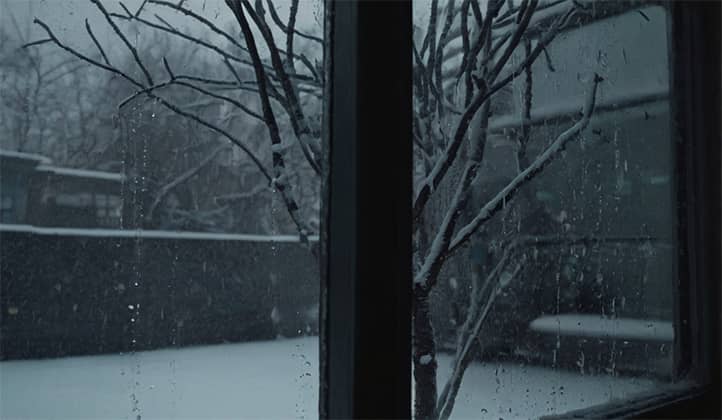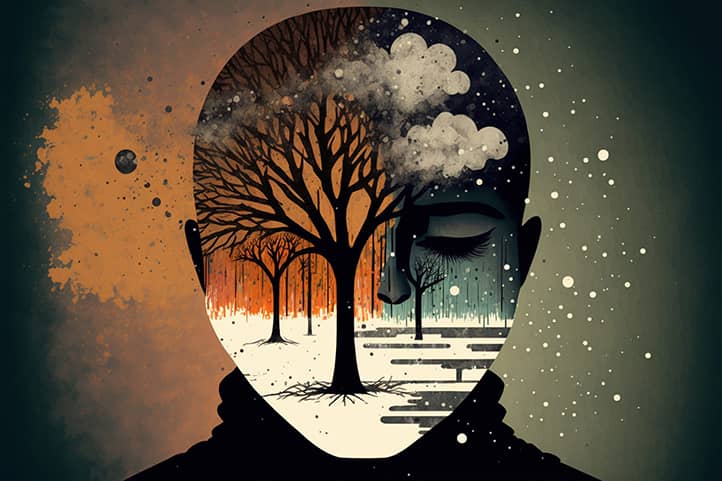Seasonal Affective Disorder (SAD) is a form of depression that occurs during specific times of the year, most often in the fall and winter, when daylight hours decrease and sunlight becomes scarce. This condition is accompanied by feelings of sadness, fatigue, a loss of interest in usual activities, and other unpleasant symptoms that can significantly affect quality of life. People dealing with SAD often feel drained, isolated, and emotionally exhausted, even if their lives appear stable and free of major problems.
Statistics show that seasonal affective disorder affects approximately 5–10% of the population in countries with a temperate climate, with women being twice as likely to experience it compared to men. Additionally, about 15% of people may experience mild symptoms that, while not reaching the level of clinical depression, still negatively impact their emotional state. The highest incidence of SAD is recorded in regions with long winters and minimal sunny days. For instance, in northern countries like Norway and Finland, up to 20% of the population may experience seasonal mood changes.
Early recognition of seasonal affective disorder is crucial, as it tends to worsen over the years if left unaddressed. Many people underestimate the seriousness of their condition, attributing it to ordinary “winter blues” or fatigue, which delays their seeking help. However, prolonged depression caused by SAD can lead to serious consequences, such as social isolation, relationship problems, reduced productivity, and even deteriorating physical health.
When diagnosed early and accurately, SAD can be managed effectively to minimize its impact on daily life and prevent recurrence in the future. Awareness of its main symptoms and risk factors, coupled with an understanding that effective treatments exist, empowers individuals to regain control over their emotional state. Seasonal affective disorder is not a life sentence but a challenge that can be overcome with awareness and determination.

What Is Seasonal Affective Disorder?
Seasonal affective disorder (SAD) is a type of depression that occurs at specific times of the year, typically in the fall or winter, and subsides in the spring or summer. Also known as “seasonal depression,” it is closely linked to changes in natural light, which affect the body’s biological rhythms. While most people experience a slight decrease in energy and mood during short winter days, SAD symptoms are so pronounced that they interfere with daily life and responsibilities.
SAD is classified within the spectrum of affective disorders and is officially recognized in psychiatry as a subtype of major depressive disorder or, in some cases, bipolar disorder. This means that individuals may experience significant mood deterioration, apathy, reduced physical activity, and other depression-related symptoms, with their onset clearly tied to seasonal changes.
The Concept and Scientific Definition of SAD
From a scientific perspective, seasonal affective disorder is defined as a recurring mood disorder characterized by depressive episodes that occur during a specific season for at least two consecutive years. According to the DSM-5 (Diagnostic and Statistical Manual of Mental Disorders), SAD is categorized as a major depressive disorder with a seasonal pattern. Its primary symptoms include a depressed mood, loss of interest in favorite activities, persistent fatigue, difficulty concentrating, and changes in appetite and sleep patterns.
A key feature of SAD is the seasonal nature of its symptoms: they emerge during the fall-winter period, when daylight hours decrease, and fully or partially disappear in the spring and summer. While SAD is most commonly associated with winter depression, there are rare forms of the disorder that manifest during the summer.
How Does It Differ from Other Types of Depression?
Seasonal affective disorder has several distinguishing features compared to other types of depression. The most notable is its clear seasonal link: while other forms of depression can occur at any time, SAD manifests only during specific times of the year. Another distinctive trait is the presence of unique symptoms, such as increased sleepiness, heightened appetite (especially cravings for sweets and carbohydrates), and weight gain.
In contrast, other forms of depression often involve difficulties with sleep or a complete loss of appetite. Additionally, seasonal depression is less influenced by external factors such as stress or traumatic events and more dependent on biological processes, particularly changes in hormonal balance and circadian rhythms.
Key Risk Factors
Several key risk factors increase the likelihood of developing seasonal affective disorder:
- Seasonal changes and short days: The reduction in daylight hours during the fall and winter is the primary trigger for SAD. This disrupts the body’s natural biological rhythms, which regulate sleep and wake cycles.
- Lack of sunlight: During the winter months, natural light levels decrease significantly, affecting the production of melatonin—a hormone that regulates sleep. Excess melatonin leads to sleepiness, fatigue, and difficulty concentrating.
- Changes in serotonin levels: Sunlight also impacts serotonin levels—a neurotransmitter responsible for mood regulation. A decrease in its concentration can cause a depressed mood and other depressive symptoms.
- Genetic predisposition: People with relatives who suffer from SAD or other forms of depression are at a higher risk of developing this disorder.
- Geographical location: Residents of northern regions with long winters and minimal sunny days are more prone to SAD compared to those living closer to the equator.
These factors collectively create conditions conducive to the development of seasonal affective disorder. However, proper diagnosis and timely preventive measures can help minimize its impact on life.

Main Symptoms of Seasonal Affective Disorder
Seasonal Affective Disorder (SAD) manifests through a variety of symptoms that affect emotional, physical, cognitive, and social aspects of life. These symptoms can vary in intensity depending on individual characteristics but share a common feature: they appear during the fall and winter months, significantly impacting daily life.
One of the key traits of SAD is that its symptoms are often mistaken for ordinary fatigue or the so-called “winter blues,” leading many people to overlook them. However, ignoring these signs can result in their worsening, potentially leading to severe depressive states. The symptoms of SAD are generally categorized into four main groups: emotional, physical, cognitive, and social, each with its own distinct features.
Emotional Symptoms
People suffering from SAD often experience persistent fatigue and apathy. They may lose energy and motivation even for the simplest tasks. Daily responsibilities become incredibly challenging, and interest in previously enjoyable activities disappears. This state is frequently accompanied by a sense of emotional exhaustion, where individuals fail to find joy in things that used to bring them pleasure.
Another common manifestation is a feeling of sadness, anxiety, and irritability. Sadness may persist for most of the day, even without an apparent reason. Irritability and heightened emotional sensitivity are also typical of SAD, with minor everyday situations becoming disproportionately upsetting. These emotions are often accompanied by anxious thoughts and a sense of hopelessness.
Physical Symptoms
One of the most noticeable physical symptoms of SAD is sleep disturbances, such as excessive sleepiness or insomnia. Individuals may feel an ongoing desire to sleep, even when spending more time in bed than usual. Despite extended rest, waking up becomes harder, and daytime fatigue persists. In some cases, difficulties with falling asleep or excessive sleep duration are observed.
Another common symptom is an increased appetite, particularly cravings for carbohydrates and sweets. People with SAD often feel the need for a quick “energy boost” through food, leading to overeating and weight gain. This, in turn, can cause additional concerns about appearance and health.
Cognitive Symptoms
SAD significantly affects cognitive functions. People often struggle with concentrating, finding even simple tasks require more time and effort than usual. Decision-making becomes difficult due to a sense of self-doubt.
Work or academic productivity decreases as it becomes harder to stay focused. Individuals may forget important information or procrastinate due to a lack of energy and motivation.
Social Symptoms
SAD also impacts the social sphere of life. One of the most common signs is a feeling of isolation and reduced interest in social interactions. People may avoid meeting with friends or family, preferring to spend more time alone. Even brief social interactions can feel overly demanding.
Interest in hobbies and activities that previously brought joy declines. This can create a vicious cycle: individuals avoid socializing due to fatigue, but this isolation only worsens their depressive state.
In conclusion, Seasonal Affective Disorder encompasses a broad range of symptoms that affect various aspects of life. Timely recognition and response to these symptoms can minimize the disorder’s impact on emotional well-being and improve the quality of life, even during the darkest winter days.

Causes of Seasonal Affective Disorder
Seasonal Affective Disorder (SAD) arises from the interplay of biological, environmental, and genetic factors. While researchers have yet to fully understand all the mechanisms behind this condition, there is sufficient scientific evidence to highlight its primary causes. Key contributors include changes in daylight duration, hormonal imbalances, and genetic predisposition.
The shortening of daylight hours in autumn and winter triggers significant changes in the body, disrupting circadian rhythms—the internal “clock” that regulates the sleep-wake cycle. This disruption affects hormone production, particularly melatonin, which governs sleep, and serotonin, which influences mood. In some individuals, these changes become so pronounced that they lead to imbalances and the development of SAD.
Additionally, genetic predisposition may play a significant role. Individuals with a family history of depression or seasonal disorders are at higher risk of developing SAD. Below is a more detailed examination of the primary causes.
The Impact of Changing Daylight Duration
The alteration in daylight duration is the primary trigger for SAD. During the colder months, shorter days and reduced sunlight create challenges for the body’s adaptation.
Circadian rhythms, which govern the sleep-wake cycle, are influenced by external factors, with sunlight being the most critical. When sunlight decreases, the body’s internal “clock” may become misaligned, leading to disruptions in sleep patterns, attention span, and overall energy levels. This explains why many people with SAD experience persistent fatigue and drowsiness.
Furthermore, insufficient sunlight affects the retina’s function, which sends signals to the brain to activate areas responsible for mood and emotion regulation. When these signals weaken due to low light exposure, depressive symptoms are more likely to emerge.
The Role of Hormones: Melatonin and Serotonin
Alterations in melatonin and serotonin production are central to the development of SAD. Melatonin, a hormone regulating sleep, is produced in greater quantities during darkness. In winter, when daylight hours are reduced, melatonin levels may remain elevated throughout the day, causing persistent drowsiness, apathy, and reduced energy.
In contrast, serotonin plays a crucial role in maintaining a positive mood and a sense of well-being. Sunlight stimulates serotonin production, but during periods of limited sunlight, serotonin levels drop. This decline can result in low mood, anxiety, and other depressive symptoms. Additionally, reduced serotonin levels can increase cravings for carbohydrates and sweets, which are typical among people with SAD.
The balance between melatonin and serotonin is vital for emotional health. Disruptions to this balance caused by reduced daylight duration are one of the primary factors contributing to SAD.
Genetic Predisposition
Genetic predisposition is another significant factor in SAD development. Studies show that individuals with a family history of depression, anxiety disorders, or SAD are at a higher risk of developing the condition. This is because certain genes that regulate the production of serotonin and melatonin can be inherited from parents.
Genetic factors also influence sensitivity to changes in daylight duration. Some individuals have a more pronounced natural reaction to reduced sunlight, explaining why not everyone in regions with short winter days experiences SAD.
In summary, seasonal affective disorder results from a complex interaction of external and internal factors. Understanding these causes provides valuable insights into the nature of SAD and helps identify effective treatment strategies.

Treatment Methods for Seasonal Affective Disorder
Seasonal affective disorder (SAD) can be effectively treated through a comprehensive approach that includes light therapy, medication, psychotherapy, and lifestyle changes. The choice of methods depends on the severity of symptoms, individual characteristics, and specialist recommendations. The main goal of treatment is to alleviate the manifestations of SAD, restore energy, optimism, and the ability to enjoy life even during the darker months of the year.
Each method has its own specific features and targets the underlying causes of the disorder. For example, light therapy compensates for the lack of sunlight, which triggers hormonal changes. Medications regulate serotonin levels, reducing depressive symptoms. Psychotherapy teaches individuals to overcome negative thoughts and change their responses to stress. Lifestyle changes strengthen physical and emotional well-being, helping to combat symptoms naturally.
Light Therapy
One of the most effective treatments for SAD is light therapy, which involves using special lamps that mimic natural daylight.
A light therapy lamp emits bright light similar to sunlight, which affects the retina. The light stimulates the production of serotonin, a hormone responsible for mood regulation, and helps reduce melatonin levels, which cause drowsiness. This helps the body restore its normal balance, disrupted by short winter days.
Light therapy is usually conducted in the morning when its effectiveness is highest. The duration of a session ranges from 20 to 60 minutes, depending on the lamp’s intensity (typically 10,000 lux). For noticeable results, daily use of the lamp over several weeks is recommended. It is important for the light to reach the eyes without being overly bright to avoid discomfort.
Medication
In cases where SAD symptoms are particularly severe, doctors may recommend medication, particularly antidepressants, to regulate serotonin levels in the brain, improving emotional state and reducing anxiety. Such prescriptions require a consultation with a doctor to ensure the chosen medication is most effective for the patient.
The advantages of medication include the rapid reduction of depressive symptoms and the restoration of normal activity levels. However, antidepressants can have side effects, such as drowsiness, nausea, or weight changes, so it is essential to follow the doctor’s recommendations and undergo regular check-ups.
Psychotherapy
Psychotherapy is a vital component of SAD treatment, especially when combined with other methods, such as cognitive-behavioral therapy (CBT), which focuses on identifying negative thoughts and beliefs that may exacerbate depression. A psychotherapist helps patients replace these patterns with more positive and realistic ones, while also developing strategies for coping with stress and improving mood.
The therapist provides emotional support, helps patients better understand their own feelings, and teaches them to manage challenges. Regular sessions contribute to reducing SAD symptoms and improving quality of life.
Lifestyle Changes
Lifestyle changes can significantly alleviate SAD symptoms and improve overall well-being.
- Regular physical activity: Exercise stimulates the production of endorphins—happiness hormones that boost mood. Regular walks outdoors, even on cloudy days, also help reduce symptoms.
- Balanced diet rich in vitamins D and B: Nutrition plays an essential role in fighting SAD. Vitamin D, produced under sunlight, can be obtained from fatty fish, eggs, or dairy products. B vitamins support the nervous system, positively affecting emotional health.
- Scheduling outdoor time during daylight hours: Maximizing time spent outdoors in daylight is recommended. If this isn’t possible, setting up a workspace near a window or incorporating outdoor walks during the day can help.
Thus, treating seasonal affective disorder involves a comprehensive approach that combines various methods, each complementing the others. Timely therapy can significantly ease symptoms and restore a fulfilling quality of life even during cold winter months.

Prevention of Seasonal Affective Disorder
Seasonal affective disorder (SAD) is a significant challenge for many people during the colder months, but its development can be prevented with timely preventive measures. By preparing the body for the autumn-winter period, adopting healthy habits, and maintaining open communication with loved ones, you can significantly reduce the risk of developing this condition.
Prevention of SAD is primarily about taking care of oneself, creating a favorable environment for emotional and physical comfort, and consciously managing one’s mood. It includes both physical and emotional aspects: from sticking to a daily routine and maintaining a balanced diet to openly communicating about your feelings. It’s important to remember that even small steps can have a big impact on preventing this disorder.
How to Prepare the Body for the Autumn-Winter Period?
One of the key elements in preventing SAD is preparing the body for the shorter daylight hours and seasonal changes.
- Preventing Vitamin Deficiency. Autumn is the perfect time to focus on your diet. Include foods rich in vitamin D (fish, eggs, dairy products) and B vitamins, which support the nervous system. If necessary, consult a doctor about taking vitamin supplements.
- Maintaining Physical Activity. Regular exercise not only strengthens the body but also improves mood by producing endorphins. Even daily walks outdoors in the morning or at lunchtime can help the body adjust to the changes.
- Sleep Schedule. It’s important to start following a regular sleep schedule well before the winter months. Go to bed and wake up at the same time to keep your circadian rhythms in harmony.
Habits That Help Maintain Emotional Balance
Some simple habits can become reliable protection against the development of seasonal affective disorder:
- Spending Time Outdoors. Even on cloudy days, it’s worth going for walks. Daylight, even minimal, helps maintain energy and a good mood.
- Relaxation Practices. Techniques such as meditation, breathing exercises (like “square breathing”), or yoga help reduce stress and maintain emotional balance.
- Hobbies and Creativity. Enjoyable activities help reduce SAD symptoms. For example, drawing, music, reading, or even cooking can direct attention to positive things and distract from negativity.
- Planning for Fun Activities. Plan events or activities you’ll look forward to: parties, trips, meetings with friends. This will create a positive emotional background, even on the darkest days.
The Role of Support from Loved Ones and Open Communication About Feelings
Emotional support plays a crucial role in the prevention of SAD. Don’t overlook the opportunity to share your thoughts and feelings with loved ones.
- Open Communication. Don’t be afraid to talk about your emotions. By sharing your concerns, you can receive the support and understanding you need. Loved ones can inspire, encourage, or even offer practical help.
- Creating a Supportive Environment. Spend more time with people who energize you with positivity. Sharing time together, even during simple activities, can significantly improve your emotional state.
- Support Groups or Communities. If you find it difficult to communicate with loved ones, consider joining a support group. This can be a space where you meet people with similar experiences who understand your feelings.
The prevention of seasonal affective disorder is based on caring for physical health, forming positive habits, and supporting emotional well-being through openness and communication. By starting to work on these aspects in advance, you’ll be able to more easily get through the autumn-winter period while maintaining harmony in your life.

When should you consult a doctor?
Seasonal Affective Disorder (SAD) can impact emotional well-being and quality of life to such an extent that managing symptoms alone becomes challenging. While many people cope with minor manifestations of SAD through lifestyle changes, there are situations where professional help is necessary. Timely consultation with a doctor can prevent complications, help find effective treatments, and enable a return to a fulfilling life.
It is important to understand that seeking professional help is not a sign of weakness but a responsible approach to your health. If SAD symptoms become more pronounced or persist longer than usual, it may be a signal to consult a doctor. Sometimes, individuals may underestimate the seriousness of their condition, but there are specific signs that indicate the need for expert support.
How to recognize that professional help is needed?
You can determine when it is time to consult a doctor by observing the following signs:
- Prolonged symptoms. If feelings of sadness, apathy, or constant fatigue last for more than two weeks and do not subside even after rest or changes in activity, this may indicate the need for professional assistance.
- Lack of improvement with self-help measures. Efforts to improve your condition through light therapy, exercise, or dietary changes may prove insufficient. In such cases, a doctor can help evaluate the causes and suggest alternative treatments.
- Feeling of hopelessness. If you see no prospect of improvement, find it hard to cultivate positive thinking, and your emotional state continues to deteriorate, this is also a reason to consult a specialist.
Signs that should not be ignored
Certain symptoms are more alarming and require immediate medical attention:
- Sudden mood swings. Periods of extreme apathy may alternate with episodes of anxiety or irritability, significantly affecting daily life.
- Sleep disturbances. If you are constantly struggling with insomnia or excessive sleepiness, and it interferes with daily activities, consulting a doctor for an evaluation is crucial.
- Difficulties with concentration and decision-making. Persistent forgetfulness, inability to focus, or complete even simple tasks could signal a more serious condition.
- Social isolation. If you are intentionally avoiding contact with friends, family, or colleagues without objective reasons, this is also a warning sign.
- Thoughts of self-harm or suicide. This is the most serious signal that must not be ignored. If you experience thoughts of self-harm or suicidal ideation, you should seek help from a doctor or crisis psychologist immediately. Your safety and well-being are paramount.
How to prepare for a consultation?
If you decide to consult a doctor, it is important to provide as much information as possible about your condition:
- Write down the symptoms that concern you, their duration, and intensity.
- Describe the methods you have already used to improve your condition and their effectiveness.
- Be prepared to answer questions about your sleep patterns, diet, stress levels, and physical activity.
By doing so, timely consultation with a doctor not only alleviates SAD symptoms but also prevents their recurrence in the future. The key is not to delay seeking help if you feel you need support.

Conclusions
Seasonal Affective Disorder is a reminder of how important it is to listen to your needs, notice changes in mood and condition, and act promptly. Your health is not just the absence of illness but also the ability to enjoy life, feel energetic, and remain balanced even when it is cold and dark outside.
Do not be afraid to seek support – whether from loved ones or professionals. Psychotherapy, medication, light therapy, or simply talking to a friend can be the step that helps you overcome difficulties. It is essential to remember that you are not alone and that many resources are available to ease your journey to recovery. Seeking help is not a sign of weakness but evidence of your strength and desire to care for yourself.
Find what brings you joy and peace. Maybe it is morning walks, cozy evenings with a book, a new hobby, or time spent with loved ones. Even in the coldest winter, sources of warmth and inspiration can be found if you allow yourself to be open to change and care for yourself.




